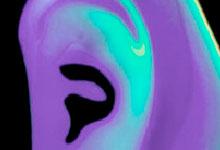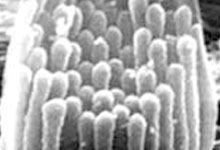

Since its inception, the NOHR Foundation has provided over $10 million for 520 separate research grants. In 2013, we are funding 10 "Seed Money" projects. Ultimately, discoveries about auditory function will lead to strategies to treat, prevent or cure hearing loss, deafness and related disorders.
ONE-YEAR SEED MONEY GRANTS
The Seed Money Program is the NOHR Foundation�s primary focus, making funds available for scientists to pursue new ideas and directions in their research.
Seed Money grants awarded by the NOHR Foundation for 2013 are supporting projects by the following principal investigators:
- Adding adaptation to cochlear implant signal processing to enhance dynamic speech features � This proposal hopes to further improve cochlear implant performance using a new implant signal processing algorithm. � Mahan Azadpour, Ph.D. (Syracuse University)
- Characterization of Lmo4 nitration in ototoxicity � Although cisplatin is used as a highly effective drug against certain cancers, it can cause hearing loss. This researcher investigates and identifies certain sensitive proteins that cause cell death with the aim of alleviating the harmful effects of cisplatin. � Samson Jamesdaniel, M.D./Ph.D. (The State University of New York, Buffalo)
- Examining coordination of Wnt and FGF signaling in controlling hair cell development and regeneration � This proposal investigates the underlying mechanisms that will allow hair cell formation in mammals. � Jason R. Meyers, Ph.D. (Colgate University)
- Cortical evoked potential measures of temporal processing � This proposal explores the information that is encoded in a child�s auditory system to advance overall understanding of hearing perception in children listening in competitive acoustic environments � Heather Porter, Ph.D. (The University of North Carolina at Chapel Hill)
- Microbial shifts in the middle ear due to genetic variants that predispose to otitis media � The middle ear infection otitis media affects a large global population. This researcher aims to study the bacterial diversity within the middle ear where there is recurrent or chronic infection and seeks ways to improve treatments and strategies to alleviate otitis media. � Regie Lyn P. Santos-Cortez, M.D./Ph.D. (Baylor College of Medicine)
- Animal model of hyperacusis caused by salicylate and noise exposure � Hyperacusis refers to a marked intolerance of ordinary environmental sound and is a common symptom related to a variety of neurological diseases such as migraine, autism and tinnitus. Aim: to determine the loudness perception change caused by high doses of salicylate and noise exposure. � Wei Sun, Ph.D. (The State University of New York, Buffalo)
- The functional role of RGMa/Neogenin pathway in spiral ganglion neuron growth and regeneration in the mammalian organ of Corti � With sensoineural hearing loss, patients suffer damages and/or degeneration of the spiral ganglian neurons which are needed to restore hearing. This grant hopes to produce results that are relevant to the regeneration of fibers in cochlea after noise trauma. � Mingjie Tong, Ph.D. (Massachusetts Eye and Ear Infirmary)
- Relationship between acoustic change complex and mismatched negativity in normal and hard-of-hearing infants � This proposal explores the nature of information about speech processing in young infants who cannot provide us with voluntary responses. The question whether physiological techniques can provide information on hearing aid fitting is important and timely. � Kristin, Uhler, Ph.D. (University of Colorado, Denver)
- Electric-acoustic stimulation and its cortical representation � This research seeks to understand the speech cues that enable cochlear implant (CI) users to use a CI in one canal and a hearing aid in another. � Yang-soo Yoon, Ph.D. (Cincinnati Children�s Hospital Medical Center)
- Understanding and restoring the USH2 complex in cochlear hair cells � This proposal hopes to significantly advance our understanding of Usher Syndrome which is a disease that causes inherited deafness and blindness. The particular approach used may also reveal a potential cure for the hearing loss that occurs. � Junhuang Zou, Ph.D. (University of Utah)
MULTI-YEAR INNER EAR HAIR CELL REGENERATION RESEARCH INITIATIVE GRANTS
The NOHR Foundation provided one investigation 200,000 for two years (2008-2009) for an inner ear hair cell regeneration program; provided a total of 2.5 million to two investigations for five years (2001-2005) for hair cell regeneration programs; and provided one program a total of $300,000 for a three-year (2001-2003) inner ear hair cell regeneration project.
ACCOMPLISHMENTS:
TWO-YEAR PROGRAM (2008-2009)
Tatjana Piotrowski, Ph.D. & Alejandro Sanchez Alvarado, Ph.D., University of Utah School of Medicine
In a bioinformatics and genetic investigation in zebrafish,
- a mutant in which hair cells form normally but fail to properly regenerate once damaged (as occurs in mammals) has been identified
- genes in a cell communication pathway (Wnt) that respond to the injury and death of hair cells have been discovered and cloned
https://research.stowers.org/piotrowskilab/Grants.php
FIVE-YEAR PROGRAM (2001-2005)
Neil Segil, Ph.D. and Andrew Groves, Ph.D. House Ear Institute, Los Angeles
Studying embryonic and postnatal mice, they have discovered:
- auditory supporting cells from newborns can spontaneously change into hair cells under culture conditions
- a gene called p27Kip1 blocks this process in the inner ear
- in mutant mice lacking p27Kip1, cells were able to divide and make hair cells
https://www.hei.org
Michael Lovett, Ph.D. and Mark Warchol, Ph.D. ,Washington University, St. Louis
In microarray studies of cochlear and vestibular avian ear genes,
- specific genes that are switched on and off during the process of inner ear hair cell regeneration after damage have been discovered
- new genomic techniques to shut down/off genes and investigate subsequent changes in other genes and in the regeneration process were developed
- genetic components of regeneration in balance structures have been revealed
THREE-YEAR PROGRAM (2001-2003)
Douglas A. Cotanche, Ph.D. Children�s Hospital, Boston
- developed embryonic mammalian cochlear cultures to serve as neural stem cell transplant recipients
- discovered neural stem cells transplanted into cochlear cultures do differentiate into cochlear cells
Johns Hopkins University
 |
National Institute on Deafness and Other Communication Disorders www.nidcd.nih.gov |
 |
Association for Research in Otolaryngology www.aro.org |
 |
American Academy of Otolaryngology www.entnet.org |
 |
Sophie SoundCheck www.sophiesoundcheck.org |







